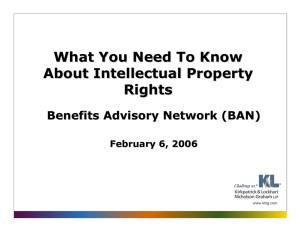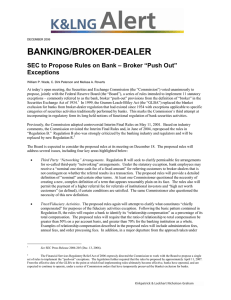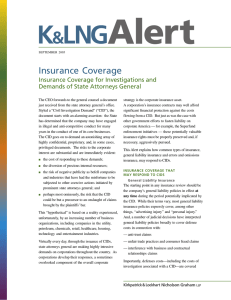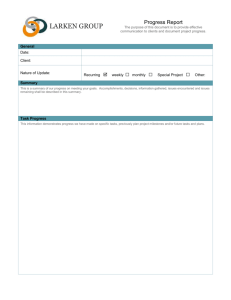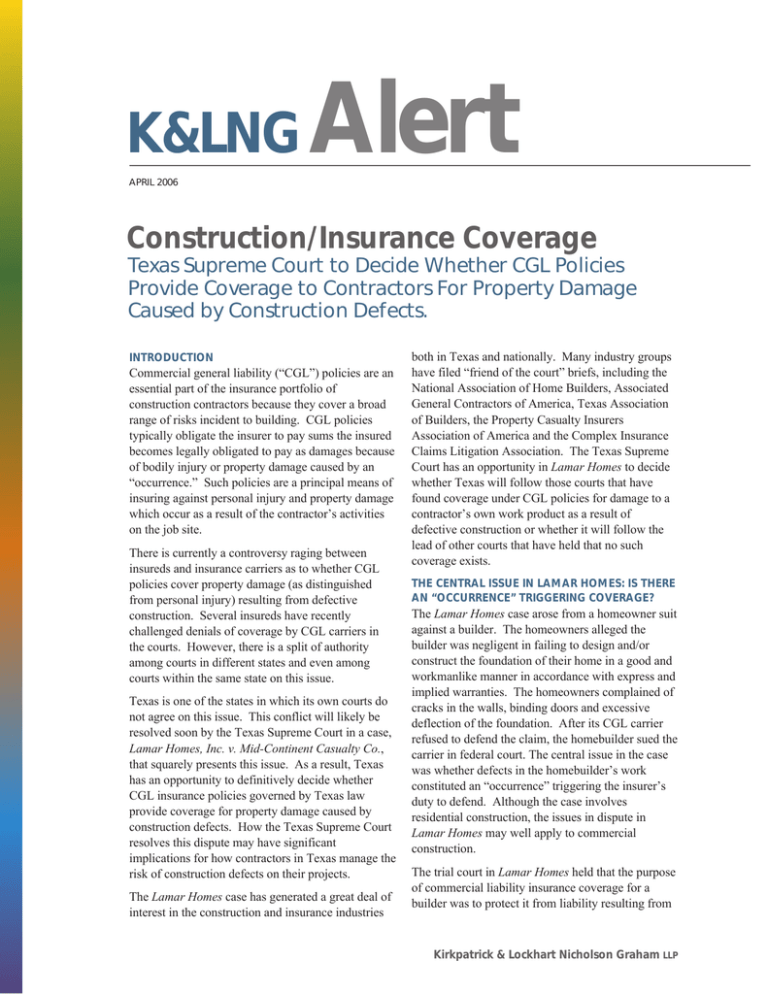
K&LNG
Alert
APRIL 2006
Construction/Insurance Coverage
Texas Supreme Court to Decide Whether CGL Policies
Provide Coverage to Contractors For Property Damage
Caused by Construction Defects.
INTRODUCTION
Commercial general liability (“CGL”) policies are an
essential part of the insurance portfolio of
construction contractors because they cover a broad
range of risks incident to building. CGL policies
typically obligate the insurer to pay sums the insured
becomes legally obligated to pay as damages because
of bodily injury or property damage caused by an
“occurrence.” Such policies are a principal means of
insuring against personal injury and property damage
which occur as a result of the contractor’s activities
on the job site.
There is currently a controversy raging between
insureds and insurance carriers as to whether CGL
policies cover property damage (as distinguished
from personal injury) resulting from defective
construction. Several insureds have recently
challenged denials of coverage by CGL carriers in
the courts. However, there is a split of authority
among courts in different states and even among
courts within the same state on this issue.
Texas is one of the states in which its own courts do
not agree on this issue. This conflict will likely be
resolved soon by the Texas Supreme Court in a case,
Lamar Homes, Inc. v. Mid-Continent Casualty Co.,
that squarely presents this issue. As a result, Texas
has an opportunity to definitively decide whether
CGL insurance policies governed by Texas law
provide coverage for property damage caused by
construction defects. How the Texas Supreme Court
resolves this dispute may have significant
implications for how contractors in Texas manage the
risk of construction defects on their projects.
The Lamar Homes case has generated a great deal of
interest in the construction and insurance industries
both in Texas and nationally. Many industry groups
have filed “friend of the court” briefs, including the
National Association of Home Builders, Associated
General Contractors of America, Texas Association
of Builders, the Property Casualty Insurers
Association of America and the Complex Insurance
Claims Litigation Association. The Texas Supreme
Court has an opportunity in Lamar Homes to decide
whether Texas will follow those courts that have
found coverage under CGL policies for damage to a
contractor’s own work product as a result of
defective construction or whether it will follow the
lead of other courts that have held that no such
coverage exists.
THE CENTRAL ISSUE IN LAMAR HOMES: IS THERE
AN “OCCURRENCE” TRIGGERING COVERAGE?
The Lamar Homes case arose from a homeowner suit
against a builder. The homeowners alleged the
builder was negligent in failing to design and/or
construct the foundation of their home in a good and
workmanlike manner in accordance with express and
implied warranties. The homeowners complained of
cracks in the walls, binding doors and excessive
deflection of the foundation. After its CGL carrier
refused to defend the claim, the homebuilder sued the
carrier in federal court. The central issue in the case
was whether defects in the homebuilder’s work
constituted an “occurrence” triggering the insurer’s
duty to defend. Although the case involves
residential construction, the issues in dispute in
Lamar Homes may well apply to commercial
construction.
The trial court in Lamar Homes held that the purpose
of commercial liability insurance coverage for a
builder was to protect it from liability resulting from
Kirkpatrick & Lockhart Nicholson Graham LLP
property damage (or bodily injury) caused by the
insured’s product, but not for the replacement or
repair of that product. The court in its opinion
expressed concern that if an insurance policy were to
be interpreted as providing coverage for construction
deficiencies, it would allow a contractor to receive
initial payment for the work from the homeowner,
then receive subsequent payment from his insurance
company to repair and correct deficiencies in his own
work.
Notwithstanding that the plaintiffs alleged the builder
was negligent, the court concluded that since the
plaintiffs sought recovery of economic loss for
damage only to the home, the real basis of their
complaint was breach of warranty, i.e., that Lamar
Homes did not build the Plaintiffs’ home in the
fashion and to the standard represented. It thus
reasoned that the claim sounded in contract, did not
involve an “accident” and thus the CGL policy
provided no coverage.
In the ensuing appeal brought by Lamar Homes, the
U.S. Court of Appeals for the Fifth Circuit found that
the issue at the heart of the case was unsettled under
Texas law and thus certified the following questions
to be answered by the Texas Supreme Court as the
final authority on questions of Texas civil law:
(1) when a home buyer sues his general
contractor for construction defects and alleges
only damage to or loss of use of the home itself,
do such allegations allege an “accident” or
“occurrence” sufficient to trigger the duty to
defend or indemnity under a CGL policy?, and
(2) when a home buyer sues his general
contractor for construction defects and alleges
only damage to or loss of use of the home itself,
do such allegations allege “property damage”
sufficient to trigger the duty to defend or
indemnify under a CGL policy?1
“Occurrence” is defined in many CGL policies as
“an accident, including continuous or repeated
exposure to substantially the same general harmful
conditions.” Such policies typically do not define the
term “accident.” This has led to differing
interpretations as to what events constitute accidents
triggering coverage, thus contributing to the current
controversy. The Texas Supreme Court in a previous
case ruled that an injury is “accidental” for purposes
of CGL coverage if “from the view point of the
insured it is not the natural and probable consequence
of the action or occurrence which produced the
injury; or in other words, if the injury could not
reasonably be anticipated by the insured, or would
not ordinarily follow from the action or occurrence
which caused the injury.”2
In the Lamar Homes case before the Texas Supreme
Court, the insurer Mid-Continent contended that
there is no coverage under a CGL policy for
defective workmanship because it is an uninsurable
business risk. Arguing that the insured intended to
perform the work that resulted in defects, the insurer
contended the damages resulted from a breach of
contract, not an accident within the scope of
coverage. Lamar Homes countered that the language
of the policy, which should be the basis for
determining whether coverage exists, makes no
distinction between contract and tort theories of
liability.
While Lamar Homes conceded that coverage does
not exist for repair or replacement of the defective
work itself, it contended that coverage exists for the
property damage done to work other than the
defective foundation in the form of cracks in the
walls and floors of the house. Lamar Homes argued
that because the work was undertaken with the intent
to perform it correctly, the consequences of
unintended defects are accidental and thus covered.
Because building a building is always a volitional
act, Lamar Homes contended the test for coverage
should be whether the defective work was the result
of negligence, as opposed to being intentional.
An analogy that illustrates the builder’s position is as
follows: that auto insurers do not deny coverage for
car accidents on the grounds the accident was caused
by the insured’s volitional act of driving the car when
an unintended consequence of driving, i.e. a crash,
occurs. Thus when intentionally performed acts not
intended to cause harm nonetheless do so as a result
of the insured’s negligence, there should be a duty on
the part of the insurer to defend. To rule otherwise
would render the insurance coverage illusory.
Although courts have taken different positions,
Lamar Homes has the better argument that
construction defects are a covered occurrence
provided the defect resulted from negligence and not
an intentional tort.
1 Lamar Homes v. Mid-Continent Cas. Co., 428 F.3d 193, 196-98 (5th Cir. 2005).
2 Mid-Century Ins. Co. v. Lindsey, 997 S.W. 2d 153, 155 (Tex. 1999).
2
Kirkpatrick & Lockhart Nicholson Graham
LLP
|
APRIL 2006
IS COVERAGE SUBJECT TO AN EXCLUSION?
Although not at issue in Lamar Homes, some
insurers have also disputed whether, assuming
coverage exists under the policy coverage clause,
certain exclusions in the CGL policy negate coverage
for this type of claim. An exclusion commonly
relied upon by carriers in declining to defend an
insured is for damage to the builder’s own work.
Many CGL policies define the insured’s own work as
(1) work or operations performed by the insured or
on its behalf; and (2) materials, parts or equipment
furnished in connection with such work or operations
and includes warranties or representations made at
any time with respect to the fitness, quality,
durability, performance or use of the insured’s work.
This exclusion is subject to an exception when the
work was performed by a subcontractor. However,
some carriers eliminate this exception through a new
endorsement to the policy. Interestingly, carriers
typically acknowledge coverage under subcontractor
CGL policies when the subcontractor’s work causes
damage to work performed by others. However, the
same carrier has been known to deny coverage to the
general contractor for the same defect on the same
job, presumably on the theory that the general
contractor’s “own work” includes the work
performed by all the subcontractors.
Another exclusion commonly relied on by insurers to
deny coverage is for damage to real property being
worked on if the damage arises out of the work
operations. This exclusion applies only while the
work is ongoing or to damage discovered while the
work is ongoing. Some carriers are deleting this
exception by endorsement, thus broadening the
exclusion to include damage discovered after the
3
project is completed. In order to determine just what
coverage is being purchased, the contractor must
review its policy, including all endorsements, in
detail.
CONCLUSION
Only time will tell how the Texas Supreme Court
will decide this issue. If Lamar Homes prevails and
the Court finds coverage for defect claims,
contractors should become familiar with the
conditions under which such coverage exists and the
potential effect of any exclusions so as to take
maximum advantage of their insurance coverage.
Should the Court instead decide in favor of the
insurer, contractors who rely on their CGL policies to
cover the risk that property damage results from
defective construction should examine alternative
strategies for dealing with this risk. These strategies
may include reviewing a new or renewal policy
carefully for non-standard provisions and
endorsements so as to fully inform themselves about
what coverage they are purchasing, taking advantage
of the subcontractors’ CGL coverage by requiring the
general contractor to be listed on their policies as an
additional insured, performing all of the work
through subcontractors, self-insuring by pricing the
work for this risk, and enhanced jobsite inspection
and quality-control programs, especially for critical
components like the foundation and structure.
PAUL E. RIDLEY
pridley@klng.com
214.939.4905
Kirkpatrick & Lockhart Nicholson Graham
LLP
|
APRIL 2006
If you have questions or would like more information about K&LNG’s Insurance Coverage Practice, please contact one of
our lawyers listed below.
International Contact
Boston
Dallas
Harrisburg
London
Los Angeles
Miami
Newark
New York
Pittsburgh
San Francisco
Washington
Peter J. Kalis
John M. Edwards
Paul E. Ridley
Carleton O. Strouss
Jane V. Harte-Lovelace
David P. Schack
Daniel A. Casey
Anthony P. La Rocco
Peter J. Kalis
Thomas M. Reiter
Edward P. Sangster
Matthew L. Jacobs
pkalis@klng.com
jedwards@klng.com
pridley@klng.com
cstrouss@klng.com
jharte-lovelace@klng.com
dschack@klng.com
dcasey@klng.com
alarocco@klng.com
pkalis@klng.com
treiter@klng.com
esangster@klng.com
mjacobs@klng.com
+1.412.355.6562
+1.617.261.3123
+1.214.939.4905
+1.717.231.4503
+44 (0) 20 7648 8172
+1.310.552.5061
+1.305.539.3324
+1.973.848.4014
+1.212.536.4828
+1.412.355.8274
+1.415.249.1028
+1.202.778.9393
Fax +1.412.355.6501
Fax +1.617.261.3175
Fax +1.214.939.4949
Fax +1.717.231.4501
Fax +44 (0) 20 7648 9001
Fax +1.310.552.5001
Fax +1.305.358.7095
Fax +1.973.848.4001
Fax +1.212.536.3901
Fax +1.412.355.6501
Fax +1.415.249.1001
Fax +1.202.778.9100
If you have questions about this topic or would like more information on Kirkpatrick & Lockhart Nicholson Graham LLP,
please contact one of our lawyers listed below:
International Contact
Boston
Dallas
Harrisburg
London
Los Angeles
Miami
Newark
New York
Pittsburgh
San Francisco
Washington
John R. Dingess
Mark E. Haddad
Paul E. Ridley
Carleton O. Strouss
Andrew L. Swope
Kevin Greene
James Hudson
David Race
Paul W. Sweeney, Jr.
Robert B. Galt, III
Anthony P. La Rocco
Michael R. Gordon
George P. Foster
Joseph L. Luciana, III.
Richard F. Paciaroni
Jonathan M. Cohen
Edward P. Sangster
David T. Case
jdingess@klng.com
mhaddad@klng.com
pridley@klng.com
cstrouss@klng.com
aswope@klng.com
kgreene@klng.com
jhudson@klng.com
drace@klng.com
psweeney@kl.com
rgalt@klng.com
alarocco@klng.com
mgordon@klng.com
gfoster@klng.com
jluciana@klng.com
rpaciaroni@klng.com
jcohen@klng.com
esangster@klng.com
dcase@klng.com
+1.412.355.6564
+1.617.261.3116
+1.214.939.4905
+1.717.231.4503
+1.717.231.4512
+44 (0) 20 73608188
+44 (0) 20 73608150
+44 (0) 20 73608106
+1.310.552.5055
+1.305.539.3311
+1.973.848.4014
+1.212.536.4855
+1.412.355.6709
+1.412.355.8982
+1.412.355.6767
+1.415.249.1029
+1.415.249.1028
+1.202.778.9084
Fax +1.412.355.6501
Fax +1.617.261.3175
Fax +1.214.939.4949
Fax +1.717.231.4501
Fax +1.717.231.4501
Fax +44 (0) 20 7648 9001
Fax +44 (0) 20 7648 9001
Fax +44 (0) 20 7648 9001
Fax +1.310.552.5001
Fax +1.305.358.7095
Fax +1.973.848.4001
Fax +1.212.536.3901
Fax +1.412.355.6501
Fax +1.412.355.6501
Fax +1.412.355.6501
Fax +1.415.249.1001
Fax +1.415.249.1001
Fax +1.202.778.9100
www.klng.com
BOSTON
■
DALLAS
■
HARRISBURG
■
LONDON
■
LOS ANGELES
■
MIAMI
■
NEWARK
■
NEW YORK
■
PALO ALTO
■
PITTSBURGH
■
SAN FRANCISCO
■
WASHINGTON
Kirkpatrick & Lockhart Nicholson Graham (K&LNG) has approximately 1,000 lawyers and represents entrepreneurs, growth and middle market companies, capital markets participants, and leading FORTUNE 100 and FTSE 100 global corporations nationally and internationally.
K&LNG is a combination of two limited liability partnerships, each named Kirkpatrick & Lockhart Nicholson Graham LLP, one qualified in Delaware,
U.S.A. and practicing from offices in Boston, Dallas, Harrisburg, Los Angeles, Miami, Newark, New York, Palo Alto, Pittsburgh, San Francisco and
Washington and one incorporated in England practicing from the London office.
This publication/newsletter is for informational purposes and does not contain or convey legal advice. The information herein should not be used or relied
upon in regard to any particular facts or circumstances without first consulting a lawyer.
Data Protection Act 1988—We may contact you from time to time with information on Kirkpatrick & Lockhart Nicholson Graham LLP seminars and with
our regular newsletters, which may be of interest to you. We will not provide your details to any third parties. Please e-mail cgregory@klng.com if you
would prefer not to receive this information.
© 2006 KIRKPATRICK & LOCKHART NICHOLSON GRAHAM LLP. ALL RIGHTS RESERVED.

